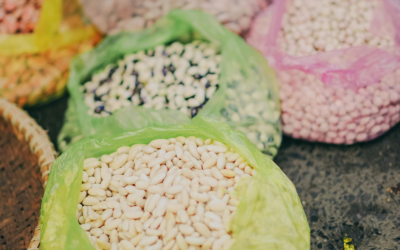Foods get the “nutrient dense” designation if they are high in nutrients but low in calories. By that definition, a nutrient-dense meal should be filled with fruits, vegetables, lean proteins, and complex carbohydrates because they have fewer calories relative to their content of vitamins, minerals, and other beneficial nutrients.
To create a nutrient-dense meal, focus on nutrients and not on calories
But a calorie- and nutrient-focused approach to healthy eating creates a rigidity in the diet that most people cannot sustain, and it undermines research that proves food quality is more important than quantity. Experts agree that foods like nuts, seeds, and avocados — though not low in calories — are highly nutritious and belong in the nutrient-dense category.
A simpler and more manageable approach is to focus on variety and balance, not on specific nutrients or calories. If we eat foods of all different colors, from all food groups, and in combination with each other, then our bodies will get the nutrients they need.
How to build a nutrient-dense meal
Assessing what you eat now is a good place to start. Do you eat from all the food groups (fruit, vegetables, protein, grains, dairy)? What is most prominent on your plate? What don’t you eat, and why? Do you enjoy what you eat and feel satisfied when you’re done?
Your plate does not have to look like a perfect rainbow, and not every meal has to be perfectly balanced or fully homemade. The best nutrient-dense meal you can create is one that marries your health goals and personal preferences. Consider the following strategies before you start creating:
- Eat a variety of foods from all the food groups. The food groups were designed to ensure people get the nutrients they need to live and grow. For example, dairy provides calcium for bone health and grains provide carbohydrates for energy. Different foods and food groups provide different types and quantities of nutrients, so the more varied your diet, the more nutrients your body gets.
- Make your plate look colorful. The bright and deep colors of produce signify the presence of vitamins, minerals, and other health-promoting compounds called antioxidants and phytonutrients. Fill your plate with multiple colors to reap the most benefits.
- Combine foods with fat, protein and carbohydrates. This will make for a more satisfying and balanced meal. Protein and fat keep us feeling full for longer, and the body uses carbohydrates as the main source of energy.
- Get enough fiber. Fiber is a type of carbohydrate that our body cannot digest but is essential for health. It helps us feel full quicker and longer because it stays in the stomach and slows digestion. Most men need 38 grams per day and most women need 25 grams. Fiber-rich foods include all fruit and vegetables, avocados, nuts, whole grains, and beans.
- Remember to eat enough. This can be hard when surrounded by messages to eat less and lose weight for our health, but our bodies won’t get the nutrients they need if we don’t eat enough. We’re all born with the ability to eat intuitively, so let your body’s hunger and fullness cues guide you throughout the meal.
Restricting or removing foods from the diet makes it more difficult to get sufficient quantities of certain nutrients. If you have to restrict food for any reason, a dietitian can help you plan for adequate nutrient intake.
Putting it on the plate
Here are some helpful tips for filling your plate with balance and variety:
-
- Make half your plate fruits and vegetables. Choose produce that fits within your budget and that you enjoy eating. If you don’t usually enjoy vegetables, try sautéing them in olive oil, spooning in herbs and spices, or drizzling them with olive oil, lemon, or another sauce.
- Fill one quarter with protein. Animal-based proteins include fish, chicken, eggs, dairy, and meat, and plant-based proteins include soy, lentils, beans, chickpeas, nuts, seeds, and quinoa.
- Fill one quarter with grains or starchy vegetables. Aim for mostly whole grains like brown and wild rice, quinoa, teff, polenta, oats, sorghum and millet. They have a higher concentration of protein, fiber, B vitamins, and minerals like iron and zinc. Starchy vegetables include sweet potato, corn, squash, yams, pumpkin, and parsnips.
- Include a serving of dairy or another source of calcium. Dairy is an excellent and affordable source of calcium, which is vital for bone health and becomes increasingly important as we age. Those who do not tolerate or prefer not to eat dairy can replace it with calcium-rich foods like salmon, tuna, kale, broccoli, tofu, and fortified items like soymilk, cereal, juice, and bread.
Use these recommendations as a guide instead of hard and fast rules, and choose foods that make you feel satisfied, not deprived. After all, pleasure is an important part of health!
If you have more questions about ways to improve your relationship with food can you can call (312) 374 – 5399 or schedule an appointment online with one of our registered dietitians.
Submitted by Emily Guzman
Edited by Alex Franz
Reviewed by Morgan Murdock
REFERENCES
Drewnowski, A. (2005). Concept of a nutritious food: Toward a nutrient density score. The American Journal of Clinical Nutrition, 82(4), 721-732. doi:10.1093/ajcn/82.4.721
Gropper, S. A., Smith, J. L., & Groff, J. L. (2018). Advanced nutrition and human metabolism. Belmont, CA: Thomson/Wadsworth.
U.S. Department of Health and Human Services and U.S. Department of Agriculture. 2015 – 2020 Dietary Guidelines for Americans. 8th Edition. December 2015










